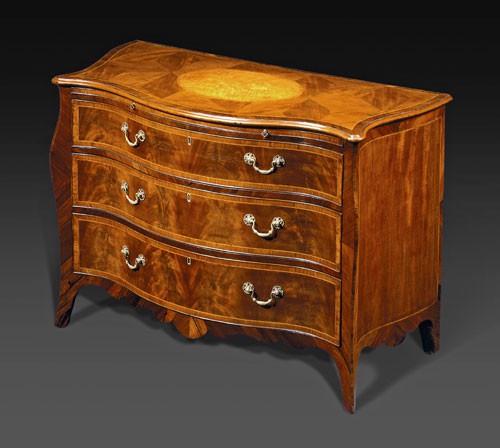
 |
|
|
 |
|
|
A George III Mahogany Serpentine Commode, Attributed To Henry Hill of MarlboroughCIRCA 1775 Height: 34.25 "Width: 50"Depth: 23.5" Inventory Number 8014-335 Price$78,000DescriptionThe parquetry top with fully serpentine-front and half-serpentine sides inlaid with a satinwood oval enclosed by tulipwood banding; the conforming case with rosewood-veneered keeled angles fitted with a brushing slide over three graduated cockbeaded drawers with bookmatched flame mahogany veneers within boxwood and sycamore stringing; over a shaped apron ending in splayed legs; crossbanded throughout in kingwood. Handles old but not original; one replaced lock. Provenances- IllustratedLiterature: L. Wood, Catalogue of Commodes, London, 1994, no. 4, pp. 64-73 L. Wood, 'Furniture for Lord Delaval: Metropolitan and Provincial,' Furniture History, vol. 26, 1990, p. 205, figs. 7-13. 19-20, 23. Additional InformationHenry Hill was a cabinetmaker in Marlborough, Wiltshire active from about 1741 until his death in 1778. Extant documentation has established that he executed furniture for a clientele consisting mainly of local landed families, including the 9th Duke of Somserset at Maiden Bradley, Arabella Calley at Burderop Park, and Paul Methuen at Corsham Court. The present commode is one of a group made by Hill, all deriving from the same form and methods of construction. The serpentine front with keeled angles, the distinct scalloped apron, the usual configuration of brushing slide over three drawers and, of course, his trademark large-scale lozenge parquetry top are all particular characteristics of this group. The construction is also consistent throughout the Hill group. The exceptionally deep cock-beading on the drawers which serve to conceal the front dove-tails are unusual in English cabinetmaking, but common in Hill’s commodes. The carcasses are made of deal and mahogany with solid sides and boarded back and the mahogany-lined drawers most often have deal bottoms usually covered by a pale blue paper, as in the present commode. Other members of this group of commodes are in the collections of the Victoria and Albert Museum, London, and the Lady Lever Art Gallery, Leeds. |
 |